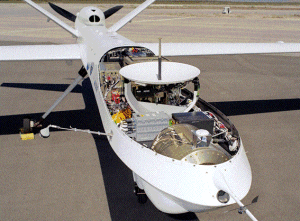Peace vs. war: what UAVs and automation tell us about the next generation of connector technology
UAVs have been employed by the military for years, and their sophistication is increasing.

Smaller and lighter components are allowing designers to give military UAVs more capabilities, and have brought previously exclusively military technologies like UAV-mounted cameras to consumer drones. As sensor technology gets smaller, lighter, and cheaper, more and more mechanical processes can be taken over by electronics. Even more importantly for the hardware component industry, including manufacturers of connectors and cables, more and more human-directed UAV activity will be automated, making additional electronic systems and sensors more prolific.
These expanding UAV sensor arrays inevitably require more cabling and connectors, with a concurrent demand for shrinking size and weight. Currently, designers are meeting these challenges with multi-port connectors, particularly the MIL-DTL-38999 Series III types. These MIL-standard, vibration, shock, and moisture resistant connectors significantly reduce redundant shielding and connector weight associated with using separate cables, and can also improve reliability and shielding.
These kinds of multi-port connectors have a long history of use in harsh environments for military and aerospace applications. Their use in UAVs is a prime example of how the success and speed of implementation of new technologies is built on the creative use of proven cable and connector components. In fact, the history of multi-pin circular connectors dates all the way back to the 1930s and the aviation demands brought about by World War II. Remarkably, aviation electronics went from just a few (comparatively crude) engine ignition parts in World War I to sophisticated, rugged circular connectors enabling projects like the Apollo missions just half a century later.
These Industrial Age innovations were driven by brute force: during World War II, defense had entire economies and workforces at its disposal, and the trend continued into the Cold War and Space Race. In the Information Age, rather than from brute force, innovations will come because automation and interconnection is actually making sensors and their supporting cables and connectors cheaper by reducing human involvement. The past century has shown, and consumer drones remind us now, that products built by defense contractors today will find their way into the next generation of consumer products.
Delegating Brain Tasks
In many contexts, computing power is replacing brain power, as direct human control is being given over to automation. Early military UAVs had to be connected via satellite because a person on the ground controls it. With more and richer sensor data available, together with advances in automation, the primary reason for connectedness is the sharing of valuable sensor data. Eventually, “unmanned” will take on new meaning as direct human control over UAVs continues to diminish. The practical upshot of this is that UAVs will become much less expensive to operate and will allow personnel to focus more and more on the strategic big picture.
In military applications, the ethics of complete automation are understandably controversial, but the same technology that is driving the proliferation of military UAVs is migrating to other applications such as commercial deliveries.
From Hellfire to Amazon
In the mid-1990s, the US military had deployed its first practical UAV, serving surveillance roles in Bosnia. By the second Iraq war, American UAVs were equipped with Hellfire missiles. In the last few years companies like Amazon have begun experimenting with using UAVs for delivering goods to consumers. Just as World War II aviation advances led to widespread commercial air travel, military UAV concepts are being adapted to less lethal applications.
One such non-military deployment of UAVs becoming widespread is in inspection and monitoring. UAVs can be employed in scenarios like railroad inspection to perform visual survey tasks like track inspection. Conceivably, these kinds of tasks will eventually also be fully automated.
Going forward though, will the direction of innovation remain the same? Will defense spending and innovations continue to trickle down to consumer products, or will the more consumer-oriented data revolution ignited in Silicon Valley bring new technology to the military? The so-called Internet of Things is defined by an explosion of sensors and sensor data in a wide range of industries, and private profit motivation may soon overtake defense spending as the source for innovations in areas like aviation electronics.
The Next Generation of Cable Assemblies
While the last 50 years have seen numerous innovations in cabling and interconnect technology for aviation, it doesn’t really compare to the half century before 1969. That period saw the shift from hand-crank airplane engine starters to landing a man on the moon. The reason for this is that the utility of each individual sensor, connector, and cable assembly has been limited by the human element. Even the incredible technology enabling military UAVs to keep soldiers out of harm’s way and strike targets precisely still requires a great deal of human involvement. Over the next 50 years, automation is the force that will massively increase demand for connector and cable components and spur a half century of real revolution.
[hr]
Neil Shurtz is a contributor to ConnectorSupplier.com based in San Francisco. As a freelancer and in his work in public relations for high-tech companies, he has written about technology in the oil and gas, aerospace, and manufacturing industries. Shurtz specializes in framing complex and niche technical topics in a broader social context.
Recently posted:
[related_posts limit=”10″]






